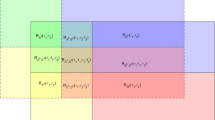Abstract
In most existing research on massive multiple-input multiple-output (MIMO) systems, theoretical analysis relies on the assumption that the number of antennas at the base station is infinite. Under this assumption, channel vectors for different users will be asymptotically orthogonal; therefore, the calculation of channel capacity can be greatly simplified. However, in practical systems, the number of antennas is always finite, and the channel vectors for different users cannot be completely orthogonal. In this paper, we propose an analytical approximation for the channel capacity of massive MIMO systems, with a finite number of antennas. Numerical results show that the derived closed-form expression is more accurate than the one assuming that the channel vectors are asymptotically orthogonal.




Similar content being viewed by others
References
Mietzner, J., Schober, R., Lampe, L., et al. (2009). Multiple-antenna techniques for wireless communications—A comprehensive literature survey. IEEE Communications Surveys & Tutorials, 11(2), 87–105.
Marzetta, T. L. (2010). Noncooperative cellular wireless with unlimited numbers of base station antennas. IEEE Transactions on Wireless Communications, 9(11), 3590–3600.
Goldsmith, A., Jafar, S. A., Jindal, N., et al. (2003). Capacity limits of MIMO channels. IEEE Journal on Selected Areas in Communications, 21(5), 684–702.
Gesbert, D., Bolcskei, H., Gore, D. A., et al. (2002). Outdoor MIMO wireless channels: Models and performance prediction. IEEE Transactions on Communications, 50(12), 1926–1934.
Gesbert, D., Shafi, M., Shiu, D., et al. (2003). From theory to practice: An overview of MIMO space-time coded wireless systems. IEEE Journal on Selected Areas in Communications, 21(3), 281–302.
Lu, L., Li, G. Y., Swindlehurst, A. L., et al. (2014). An overview of massive MIMO: Benefits and challenges. IEEE Journal of Selected Topics in Signal Processing, 8(5), 742–758.
Raghavan, V., & Sayeed, A. M. (2011). Sublinear capacity scaling laws for sparse MIMO channels. IEEE Transactions on Information Theory, 57(1), 345–364.
Goldsmith, A. (2005). Wireless communications. Cambridge: Cambridge University Press.
Hampton, J. R. (2013). Introduction to MIMO communications. Cambridge: Cambridge University Press.
Rusek, F., Persson, D., Lau, B. K., et al. (2013). Scaling up MIMO: Opportunities and challenges with very large arrays. IEEE Signal Processing Magazine, 30(1), 40–60.
Liu, Y., Tan, Z., Hu, H., et al. (2014). Channel estimation for OFDM. IEEE Communications Surveys & Tutorials, 16(4), 1891–1908.
Withers, C. S., & Nadarajah, S. (2010). Expansions for functions of determinants of power series. Canadian Applied Mathematics Quarterly, 18(1), 107–113.
Mendel, J. M. (1991). Tutorial on higher-order statistics (spectra) in signal processing and system theory: Theoretical results and some applications. Proceedings of the IEEE, 79(3), 278–305.
Liu, Y., Li, G. Y., Tan, Z., et al. (2015). Noise power estimation in SC-FDMA systems. IEEE Wireless Communications Letters, 4(2), 217–220.
Acknowledgements
Funding was provided by National High-tech R&D Program of China (863 Program) (Grant No. 2014AA01A706), National Natural Science Foundation of China (Grant No. 61471027), Fundamental Research Funds for the Central Universities (Grant No. 2017JBM306), Southeast University National Mobile Communications Research Laboratory Research Fund (Grant No. 2014D05), Beijing Municipal Natural Science Foundation (Grant No. 4152043).
Author information
Authors and Affiliations
Corresponding author
Appendices
Appendix 1
Substituting (7) into the term of \({\mathrm {E_H}}\left( \mathbf{{\Delta }} \right)\) in Eq. (10), we obtain
where \({\mathbf{{h}}_{{i}}}\) and \({\mathbf{{h}}_{{j}}}\) represent the channel responses of the i-th and j-th users.
(14) can be rewritten as
This completes the proof of Eq. (11).
Appendix 2
From (7), the expressions of \({\left[ {\mathbf {\Delta }} \right] _{\left( {i,p} \right) }}\) and \({\left[ {\mathbf {\Delta }} \right] _{\left( {p,j} \right) }}\) can be given by
Substituting (16) and (17) into \({\mathrm {E_H}}\left( {{\mathbf{{\Delta }}^2}} \right)\) in (12), we have
Using the relation between moment and cumulant [7], the first term in (18) is obtained as
Similarly,
Substituting (19) through (22) into (18), we have
Rights and permissions
About this article
Cite this article
Liu, K., Tao, C., Liu, L. et al. Analytical Approximation for Capacity in Massive MIMO Systems. Wireless Pers Commun 97, 4551–4561 (2017). https://doi.org/10.1007/s11277-017-4737-7
Published:
Issue Date:
DOI: https://doi.org/10.1007/s11277-017-4737-7




